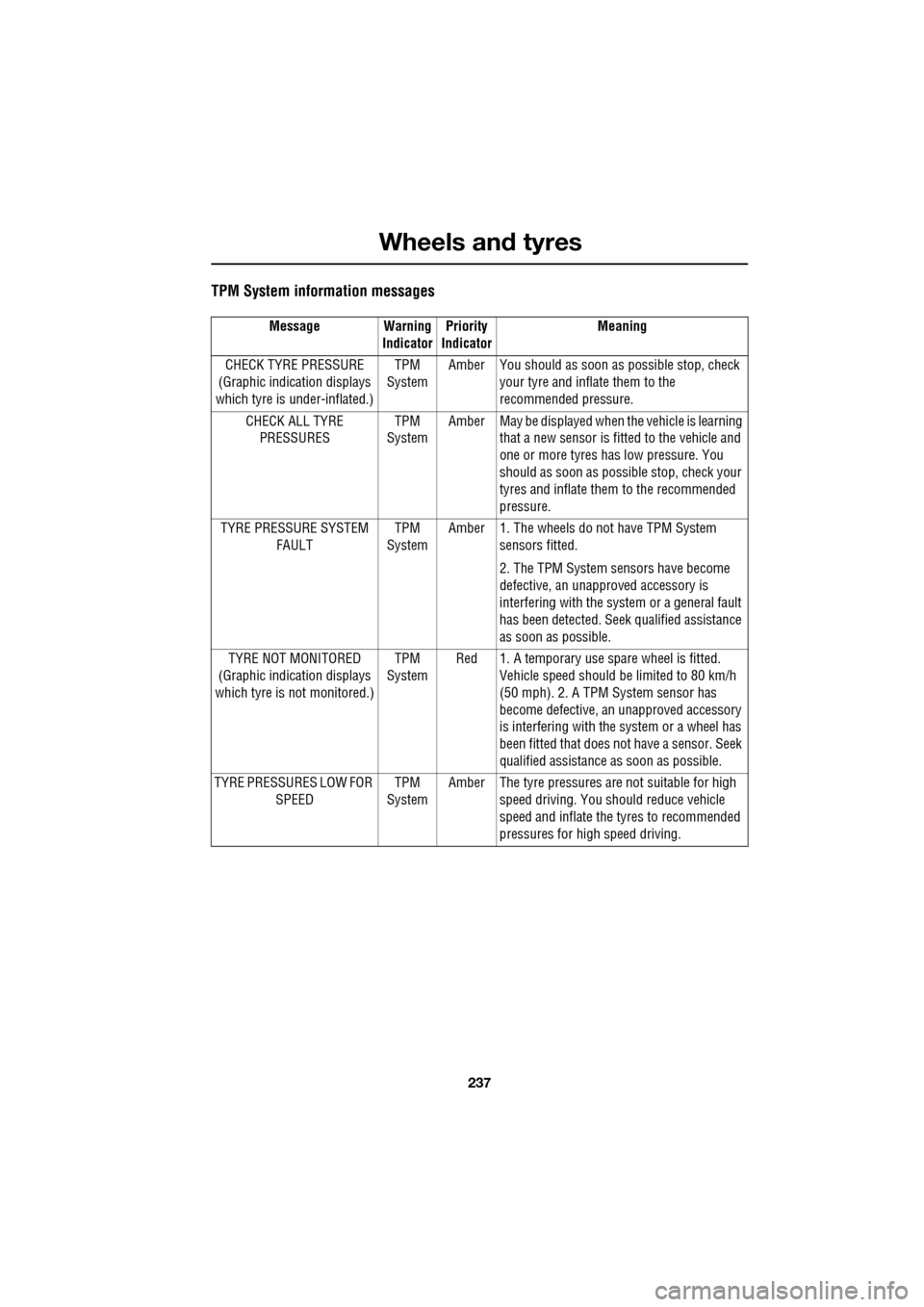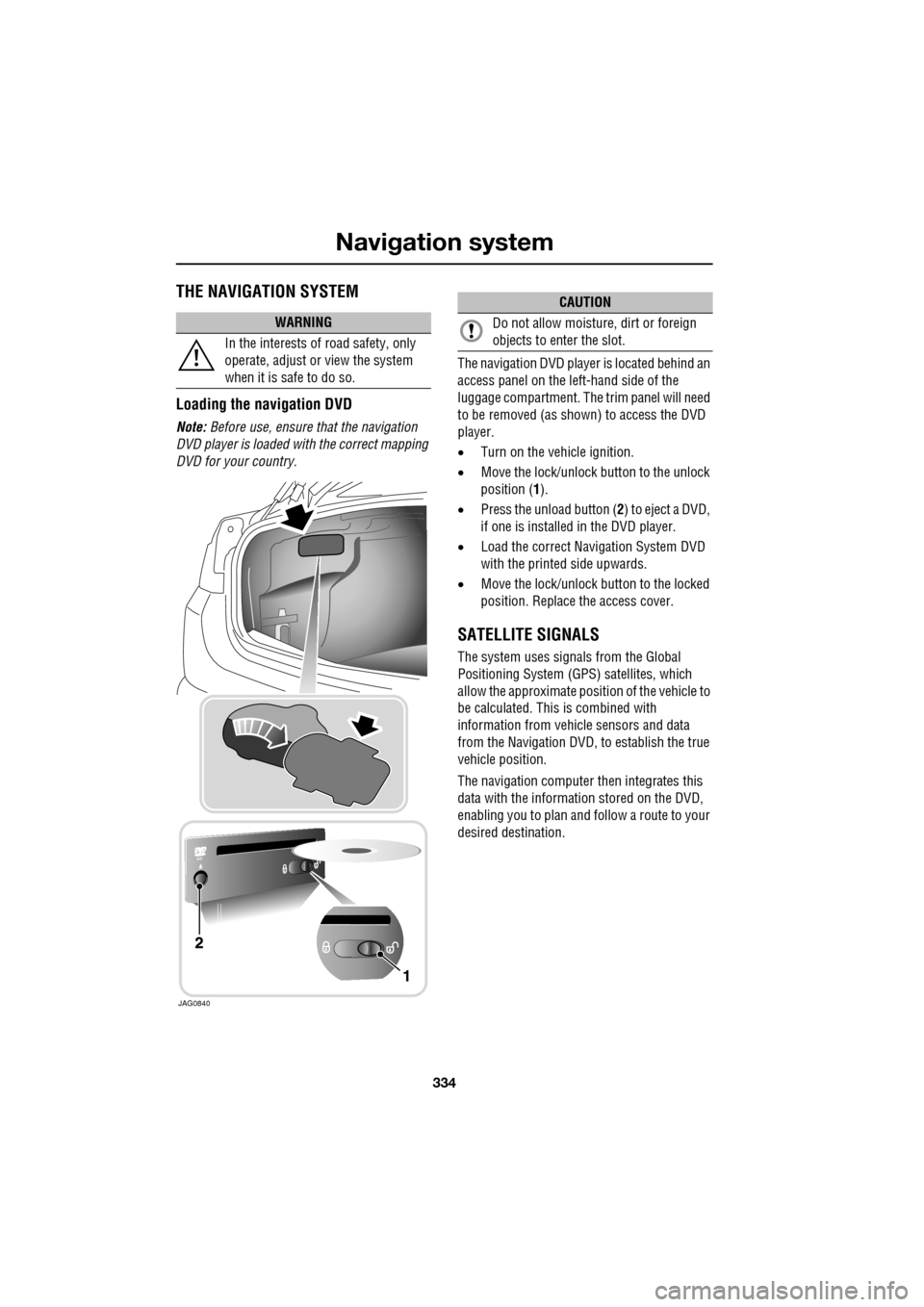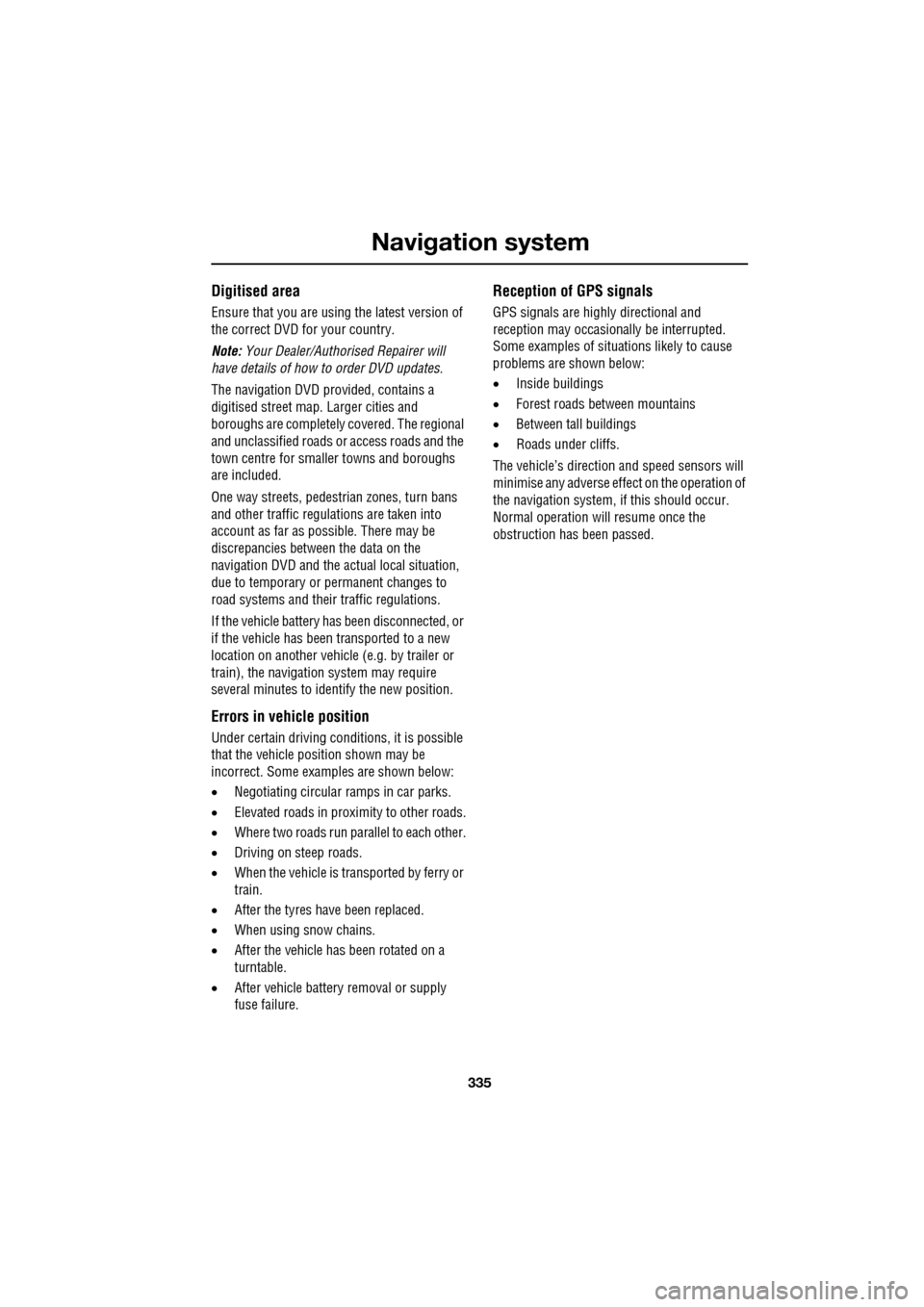Sensors JAGUAR XF 2009 1.G Owner's Manual
[x] Cancel search | Manufacturer: JAGUAR, Model Year: 2009, Model line: XF, Model: JAGUAR XF 2009 1.GPages: 391, PDF Size: 19.32 MB
Page 236 of 391

Wheels and tyres
236
Tyre pressure warning with speed
If the vehicle is to be driven at speeds in excess
of 160 km/h (100 mph), the tyre pressures
should be increased as stated in this handbook
or on the placard label. Failure to increase the
tyre pressures and driving in excess of
160 km/h (100 mph), will illuminate the yellow
warning telltale and display a text message
TYRE PRESSURES LOW FOR SPEED . In the
event of this warning be ing displayed, vehicle
speed should be reduced
Temporary use spare wheel and tyre
change
If the temporary use spare wheel is fitted the
system will automatically recognise the change
in wheel positions. The n after approximately
ten minutes of driv ing above 25 km/h
(18 mph), a message TYRE NOT MONITORED
will be displayed accompanied by illumination
of the warning telltale and the corresponding
block in the vehicle graphic.
The warning telltale will initially flash and will
subsequently revert to continuous illumination.
Extended use of the temporary use spare wheel
will produce an additional text message TYRE
PRESSURE SYSTEM FAULT .
This TPM system display sequence will be
activated at every ignition cycle until the
temporary use spare wheel is replaced by a
fully operational full size wheel and tyre
assembly.
Always replace the temporary use wheel before
having TPM system faults investigated. The
fault may well be rectified with the fitment of a
fully operational full size running tyre in lieu of
the temporary use spare wheel assembly.
Tyre changing
Always have your tyres serviced or changed by
a qualified engineer.
Care must be taken to avoid contact between
the bead of the tyre and the sensor during
removal and refitting of the tyre, otherwise the
sensor may become damaged and or
inoperable.
Sensors can be removed from the wheel by the
unscrewing of the va lve retention nut.
Replacement sensor
Should the sensor require replacing, it should
be carried out by a Dealer/Authorised Repairer.
A replacement sensor must be fitted to a
running wheel in order to be recognised by the
system. The vehicle needs to be stationary for
15 minutes during the se nsor fitment before
the system is ready to detect the new sensor.
The vehicle must be driven for a minimum of
fifteen minutes after the sensor change, and
then remain stationary for fifteen minutes to
activate full TPM system operation.
If the TPM system warning for any wheel does
not clear, even after ensuring correct inflation
and driving for more than ten minutes above
25 km/h (18 mph), you should seek qualified
assistance as soon as possible.
CAUTION
Valve stem seal, washer, nut, valve core
and cap should be replaced at every tyre
change. Valve stem seal, washer and nut must
be replaced if valve re tention nut is loosened.
Sensor units and nuts must be refitted using
correct torque figures and associated profile.
Damage to the vehicle may result if these
precautions are not taken.
Page 237 of 391

237
Wheels and tyres
TPM System information messages
Message Warning IndicatorPriority
Indicator Meaning
CHECK TYRE PRESSURE
(Graphic indication displays
which tyre is under-inflated.) TPM
System Amber You should as soon as
possible stop, check
your tyre and inflate them to the
recommended pressure.
CHECK ALL TYRE PRESSURES TPM
System Amber May be displayed when
the vehicle is learning
that a new sensor is fitted to the vehicle and
one or more tyres has low pressure. You
should as soon as possi ble stop, check your
tyres and inflate them to the recommended
pressure.
TYRE PRESSURE SYSTEM FAULT TPM
System Amber 1. The wheels do
not have TPM System
sensors fitted.
2. The TPM System se nsors have become
defective, an unapproved accessory is
interfering with the syst em or a general fault
has been detected. Seek qualified assistance
as soon as possible.
TYRE NOT MONITORED
(Graphic indication displays
which tyre is not monitored.) TPM
System Red 1. A temporary use spare wheel is fitted.
Vehicle speed should be limited to 80 km/h
(50 mph). 2. A TPM System sensor has
become defective, an unapproved accessory
is interfering with the system or a wheel has
been fitted that does not have a sensor. Seek
qualified assistance as soon as possible.
TYRE PRESSURES LOW FOR SPEED TPM
System Amber The tyre pressures ar
e not suitable for high
speed driving. You should reduce vehicle
speed and inflate the tyres to recommended
pressures for high speed driving.
Page 334 of 391

Navigation system
334
THE NAVIGATION SYSTEM
Loading the navigation DVD
Note: Before use, ensure that the navigation
DVD player is loaded with the correct mapping
DVD for your country. The navigation DV
D player is located behind an
access panel on the left-hand side of the
luggage compartment. The trim panel will need
to be removed (as shown) to access the DVD
player.
• Turn on the vehicle ignition.
• Move the lock/unlock button to the unlock
position ( 1).
• Press the unload button ( 2) to eject a DVD,
if one is installed in the DVD player.
• Load the correct Navigation System DVD
with the printed side upwards.
• Move the lock/unlock button to the locked
position. Replace the access cover.
SATELLITE SIGNALS
The system uses signa ls from the Global
Positioning Syst em (GPS) satellites, which
allow the approximate posi tion of the vehicle to
be calculated. This is combined with
information from vehi cle sensors and data
from the Navigation DVD, to establish the true
vehicle position.
The navigation computer then integrates this
data with the information stored on the DVD,
enabling you to plan and follow a route to your
desired destination.
WARNING
In the interests of road safety, only
operate, adjust or view the system
when it is safe to do so.
JAG0840
CAUTION
Do not allow moisture, dirt or foreign
objects to enter the slot.
Page 335 of 391

335
Navigation system
Digitised area
Ensure that you are using the latest version of
the correct DVD for your country.
Note: Your Dealer/Authorised Repairer will
have details of how to order DVD updates.
The navigation DVD provided, contains a
digitised street map. Larger cities and
boroughs are completely covered. The regional
and unclassified roads or access roads and the
town centre for smaller towns and boroughs
are included.
One way streets, pedestrian zones, turn bans
and other traffic regula tions are taken into
account as far as pos sible. There may be
discrepancies between the data on the
navigation DVD and the actual local situation,
due to temporary or permanent changes to
road systems and their traffic regulations.
If the vehicle battery ha s been disconnected, or
if the vehicle has been transported to a new
location on another vehicle (e.g. by trailer or
train), the navigation system may require
several minutes to iden tify the new position.
Errors in vehicle position
Under certain driving condi tions, it is possible
that the vehicle pos ition shown may be
incorrect. Some examples are shown below:
• Negotiating circular ramps in car parks.
• Elevated roads in proximity to other roads.
• Where two roads run parallel to each other.
• Driving on steep roads.
• When the vehicle is transported by ferry or
train.
• After the tyres have been replaced.
• When using snow chains.
• After the vehicle has been rotated on a
turntable.
• After vehicle battery removal or supply
fuse failure.
Reception of GPS signals
GPS signals are high ly directional and
reception may occasiona lly be interrupted.
Some examples of situations likely to cause
problems are shown below:
• Inside buildings
• Forest roads between mountains
• Between tall buildings
• Roads under cliffs.
The vehicle’s direction and speed sensors will
minimise any adverse effect on the operation of
the navigation system, if this should occur.
Normal operation will resume once the
obstruction has been passed.
Page 389 of 391

Index
389
Tyre care . . . . . . . . . . . . . . . . . . . . . . . . . 217age degradation . . . . . . . . . . . . . . . . . 221
directional tyres . . . . . . . . . . . . . . . . . 222
flat spots . . . . . . . . . . . . . . . . . . . . . . . 220
pressure compensation for ambient temperature changes . . . . . . . . . . . 219
punctured tyres. . . . . . . . . . . . . . . . . . 221
replacement tyres . . . . . . . . . . . . . . . . 222
tyre checks . . . . . . . . . . . . . . . . . . . . . 221
tyre pressures . . . . . . . . . . . . . . . . . . . 217
tyre pressures during long term vehicle storage . . . . . . . . . . . . . . . . . . . . . . 220
tyre wear . . . . . . . . . . . . . . . . . . . . . . . 220
Tyre glossary. . . . . . . . . . . . . . . . . . . . . . 238
Tyre pressure monitoring system . . . . . . 234
replacement sensor . . . . . . . . . . . . . . 236
temporary use spare wheel . . . . . . . . . 236
TPM System information messages . . 237
TPM system operation . . . . . . . . . . . . 235
tyre changing . . . . . . . . . . . . . . . . . . . 236
Tyre repair kit . . . . . . . . . . . . . . . . . . . . . 229
checking the tyre pressure after a repair. . . 233
Jaguar tyre repair kit . . . . . . . . . . . . . . 231
Jaguar tyre repair kit safety information . . . 230
using the Jaguar tyre repair kit . . . . . . 232
U
Undocking the Jaguar Smart Key . . . . . . . 21
Unlocking . . . . . . . . . . . . . . . . . . . . . . . . . 18
Using ACC . . . . . . . . . . . . . . . . . . . . . . . . 159 ACC malfunction . . . . . . . . . . . . . . . . . 163
automatic low speed switch off . . . . . 162
automatic switch off . . . . . . . . . . . . . . 162
changing the follow mode set gap . . . 161
changing the speed. . . . . . . . . . . . . . . 160
detection beam issues . . . . . . . . . . . . 163
entering the follow mode set gap . . . . 160
hints on driving with ACC . . . . . . . . . . 162
overriding the speed and follow mode 161
resuming the speed and follow mode . 162
setting the speed . . . . . . . . . . . . . . . . 160
Using booster cables. . . . . . . . . . . . . . . . 214 disconnecting the cables . . . . . . . . . . 214 Using cruise control . . . . . . . . . . . . . . . . . 156
automatic switch off. . . . . . . . . . . . . . . 157
changing the speed . . . . . . . . . . . . . . . 157
message centre information displays. . 158
resuming the speed . . . . . . . . . . . . . . . 157
setting vehicle speed . . . . . . . . . . . . . . 156
Using seat belts during pr egnancy . . . . . . . 51
Using snow chains . . . . . . . . . . . . . . . . . . 223
Using the ASL. . . . . . . . . . . . . . . . . . . . . . 167
ASL unavailable . . . . . . . . . . . . . . . . . . 168
exceeding the set speed . . . . . . . . . . . . 168
resuming ASL . . . . . . . . . . . . . . . . . . . 168
setting a speed limit . . . . . . . . . . . . . . . 167
suspending ASL . . . . . . . . . . . . . . . . . . 168
Using the parking aid . . . . . . . . . . . . . . . . 148
cleaning the sensors . . . . . . . . . . . . . . 151
front and rear parking aid. . . . . . . . . . . 150
rear fitted accessories . . . . . . . . . . . . . 151
rear parking aid . . . . . . . . . . . . . . . . . . 149
system fault . . . . . . . . . . . . . . . . . . . . . 151
touch-screen . . . . . . . . . . . . . . . . . . . . 148
Using the remote control . . . . . . . . . . . . . . 17 approach lighting . . . . . . . . . . . . . . . . . . 17
care of the Jaguar Smart Key . . . . . . . . . 18
docking the Jaguar Smart Key . . . . . . . . 20
emergency key blade . . . . . . . . . . . . . . . 25
irregular operation . . . . . . . . . . . . . . . . . 18
Jaguar Smart Key. . . . . . . . . . . . . . . . . . 17
Jaguar Smart Key system transmitters . 32
locking and arming the vehicle. . . . . . . . 19
luggage compartment . . . . . . . . . . . . . . 17
panic button . . . . . . . . . . . . . . . . . . . . . . 17
undocking the Jaguar Smart Key . . . . . . 21
unlocking and disarming the vehicle . . . 18